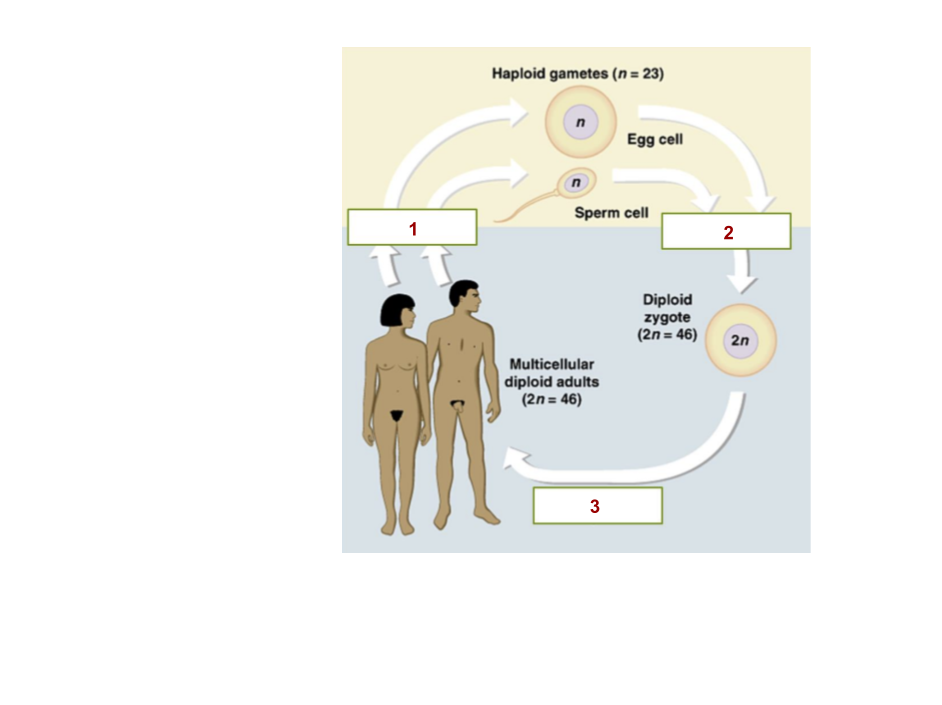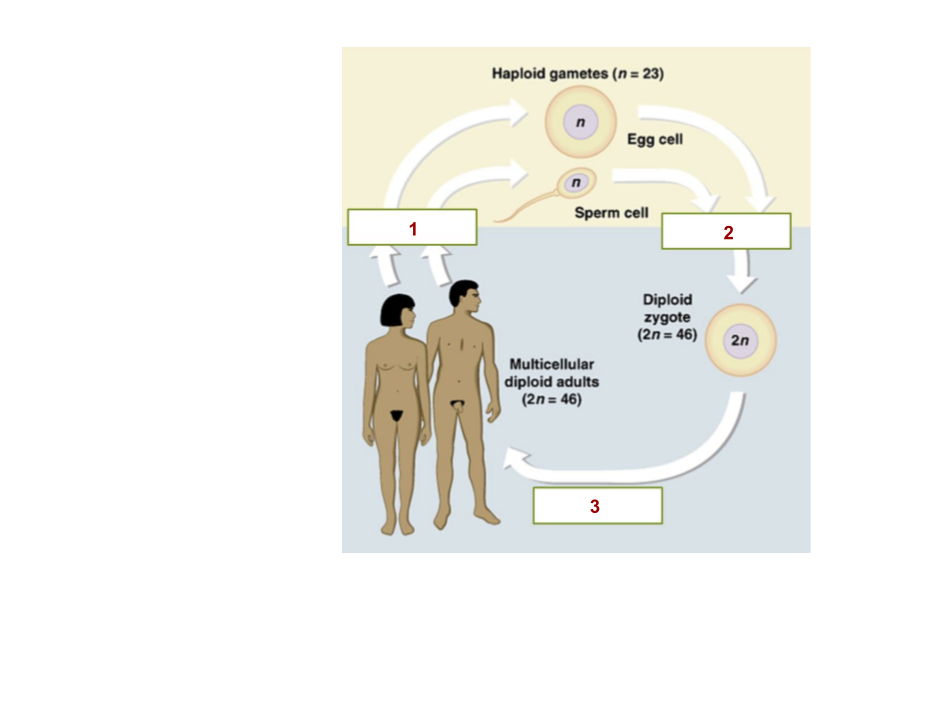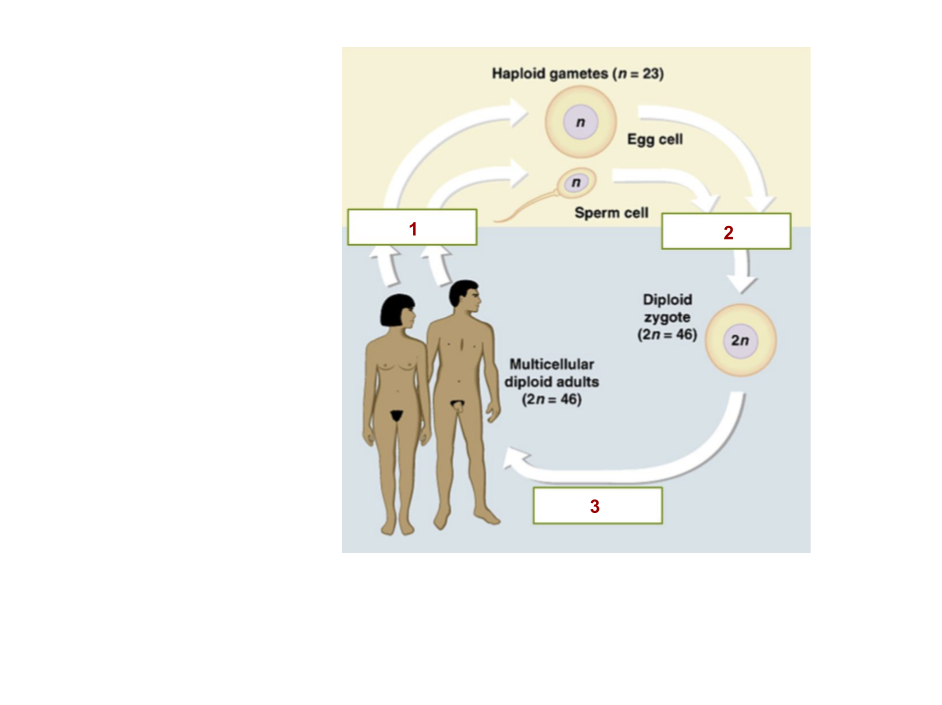Biology 30 - Unit 2 Booklet 2: Cell Division (Questions)
1/46
There's no tags or description
Looks like no tags are added yet.
Name | Mastery | Learn | Test | Matching | Spaced |
|---|
No study sessions yet.
47 Terms
How is the cell cycle divided between interphase and mitosis?
90% interphase, 10% mitosis
What are the phases in the cell cycle?
Interphase (G1, S, G2), mitosis, cytokinesis
Why does a cell need to divide?
The surface area to volume ratio of the cell decreases as it grows and it is then no longer able to supply itself with nutrients and get rid of wastes
What are the three stages of interphase?
G1 (gap 1), S (synthesis), G2 (gap 2)
Describe what happens in stage G1 of interphase (activity within cell, appearance of genetic material).
DNA transcription-translation occurs to make proteins for the growth and replication of organelles. Genetic material appears as 2n unduplicated chromatin
Describe what happens in stage S of interphase (activity within cell, appearance of genetic material).
DNA replicates by semi-conservative replication to create duplicated chromosomes. Genetic material appears as 2n duplicated chromatin
Describe what happens in stage G2 of interphase (activity within cell, appearance of genetic material).
DNA transcription-translation occurs to replicate structures associated with mitosis. Genetic material appears as 2n duplicated chromatin
What are the phases of mitosis in order?
Prophase, metaphase, anaphase, telophase followed by cytokinesis
Describe what happens in prophase (activity within cell, appearance of genetic material).
Chromatin condenses into chromosomes. Centrioles separate and move to the poles of the cell, starting to form spindle fibres. The nuclear membrane and nucleolus disappear. Genetic material appears as 2n duplicated chromosomes
Describe what happens in metaphase (activity within cell, appearance of genetic material).
Chromatid pairs align in a line on the mid-plane/equitorial plate of the cell, and spindle fibers attach to the chromosomes. Genetic material appears as 2n duplicated chromosomes
Describe what happens in anaphase (activity within cell, appearance of genetic material).
Centromeres divide and sister chromatids separate as spindle fibers pull them to opposite poles of the cell. If mitosis proceeds correctly, the same number of unreplicated chromosomes will be found at each pole. Genetic material appears as two sets of 2n unduplicated chromosomes
Describe what happens in telophase (activity within cell, appearance of genetic material).
Chromosomes uncondense to become chromatin. Spindle fibres dissolve. Nuclear membranes begin to form. The process of forming a cleavage furrow/cell plate begins. Genetic material appears as two sets of 2n unduplicated chromatin
Describe what happens in cytokinesis (activity within cell, appearance of genetic material).
A clevage furrow or cell plae forms near the equator. The mother cell divides into two nearly equal daughter cells. Genetic material appears as one set of 2n unduplicated chromatin per daughter cell.
Why is mitosis significant?
It ensures that two new identical nuclei are formed with the same number and type of chromosomes as the mother cell, mainting genetic unity in multi-cellular organisms
Why is meiosis necessary?
Reduction of chromosome number is needed for viable offspring. In addition, mitosis only produces genetically identical offspring, which does not allow for diversity within an organism; this makes the species resistant to selective pressure and could cause the eradication of the species from environmental changes
What is the 2n number for a normal human body cell?
46 chromosomes or 23 pairs of chromosomes
What is the n number for a normal human gamete?
23 chromosomes

1
Meiosis

2
Fertilization

3
Mitosis
What is the product of mitosis?
Two diploid cells with identical genetic material as the mother cell
What is the product of meiosis?
Four haploid cells with different genetic material than the mother cell
What are the phases of meiosis in order?
Meiosis 1 (prophase 1, metaphase 1, anaphase 1, telophase 1), interkinesis, then meiosis 2 (prophase 2, metaphase 2, anaphase 2, telophase 2)
Describe what happens in prophase 1 (activity within cell, appearance of genetic material).
Chromatin condenses into chromosomes. Centrioles separate and move to the poles of the cell, starting to form spindle fibres. The nuclear membrane and nucleus disappear. Homologous chromosomes move together and lie side by side in synapsis, forming a tetrad. While chromosomes are paired up, they intertwine and exchange genetic material in crossing over. Genetic material appears as 2n duplicated chromosomes
How does prophase 1 differ from prophase?
Tetrads are formed in prophase 1 and crossing over occurs, none of which occur in prophase. Crossing over creates entirely new genetic combinations not seen in the parent cell, producing variation in gametes not seen in mitosis.
Describe what happens in metaphase 1 (activity within cell, appearance of genetic material).
Homologous pairs align in a line on the metaphase plate of the cell, and spindle fibers attach to the chromosomes. Homologous pairs line up independently in independent assortment. Genetic material appears as 2n duplicated chromosomes
How does metaphase 1 differ from metaphase?
The genetic material lines up as tetrads instead of as sister chromatids; independent assortment matters because the genetic material is not completely identical
Describe what happens in anaphase 1 (activity within cell, appearance of genetic material).
Centromeres don’t divide; centrioles separate homologous pairs as spindle fibers pull them to opposite poles of the cell but sister chromatids remain attached at centromere. Genetic material appears as 2n duplicated chromosomes/2 sets of n duplicated chromosomes
How does anaphase 1 differ from anaphase?
The centromeres have not separated like in mitosis because separation in anaphase 1 occurs at the homologous pairs instead of at the centromere.
Describe what happens in telophase 1 (activity within cell, appearance of genetic material).
Chromosomes uncondense to become chromatin. Spindle fibres dissolve. Nuclear membranes begin to form. After telophase 1, cytokinesis produces two daughter cells. Genetic material appears as one set of n duplicated chromatin per daughter cell
How does telophase 1 differ from telophase?
Chromosomes that will uncondense in this phase are duplicated because they did not split at the centromere like in mitosis. Because of crossing over, the chromatids are not identical
What happens between meiosis 1 and meiosis 2?
There may or may not be a brief interkinesis prior to meiosis 2, but there is no duplication of DNA
How do meiosis 1 and meiosis 2 differ?
There is no further genetic reassortment that takes place during prophase 2, and so the cells remain as haploids. In addition, meiosis 2 is occuring to the two cells that divided from the parent cell in meiosis 1 at the same time
Describe what happens in prophase 2 (activity within cell, appearance of genetic material).
Chromatin condenses into chromosomes. Centrioles separate and move to the poles of the cell, starting to form spindle fibres. The nuclear membrane and nucleolus disappear. Genetic material appears as n duplicated chromosomes per cell
Describe what happens in metaphase 2 (activity within cell, appearance of genetic material).
Sister chromatid pairs align in a line on the metaphase plate of the cell, and spindle fibers attach to the chromosomes. Genetic material appears as n duplicated chromosomes per cell
Describe what happens in anaphase 2 (activity within cell, appearance of genetic material).
Centromeres divide and sister chromatids separate as spindle fibers pull them to opposite poles of the cell. Genetic material appears as two sets of n unduplicated chromosomes per cell
Describe what happens in telophase 2 (activity within cell, appearance of genetic material).
Chromosomes uncondense to become chromatin. Spindle fibres dissolve. Nuclear membranes and nucleoli begin to form. After telophase 2, cytokinesis produces four daughter cells. Genetic material appears as one set of n unduplicated chromatin per daughter cell
How do mitosis and meiosis compare in terms of chromosome behaviour?
In mitosis homologous chromosomes are independent while in meiosis homologous chromosomes are paired
How do mitosis and meiosis compare in terms of chromosome number and genetic identity of daughter cells?
In mitosis daughter cells are identical and diploid while in meiosis daughter cells are haploid and have a new assortment of parental chromosomes
Why does non-disjunction happen?
Pairs of homologous chromosomes do not move apart properly in anaphase 1, or sister chromatids fail to separate in anaphase 2, which will result in too many chromosomes in one pole and too little in the other (becomes a problem when the cell divides)
What is the result of non-disjunction?
Gametes produced will have an abnormal number of chromosomes, meaning the cells will lack or have too much genetic info, causing them to not function properly
A genetically normal human would have how many chromosomes of each type (autosomes, sex chromosomes)?
2 chromosomes of each type: 22 pairs of autosomes, 1 pair of sex chromosomes to yield 46 chromosomes in total
Which chromosome pair in humans can normally be non-homologous?
Sex chromosomes for males (XY)
What are the main advantages of asexual reproduction?
Only one parent required, energy efficient
What are the disadvantages of sexual reproduction?
Lots of energy wasted from lost gametes and courtship
Why do living things continue to reproduce sexually despite its major drawback?
Sexual reproduction invovled genetic recombination, which leads to greater variation among the offspring and increases the chance of survival throughout time
Why is a karyotype completed?
To screen for genetic abnormalities/non-disjunction that can help to diagnose genetic disorders